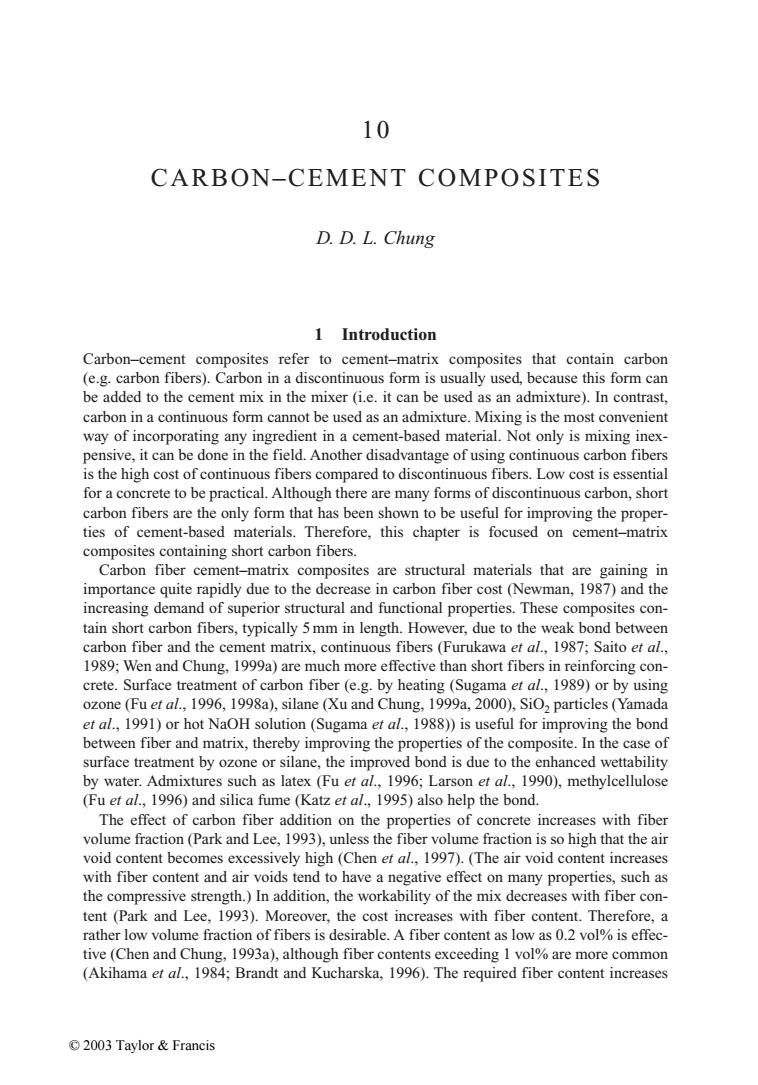正在加载图片...

10 CARBON-CEMENT COMPOSITES D.D.L.Chung 1 Introduction Carbon-cement composites refer to cement-matrix composites that contain carbon (e.g.carbon fibers).Carbon in a discontinuous form is usually used,because this form can be added to the cement mix in the mixer (i.e.it can be used as an admixture).In contrast, carbon in a continuous form cannot be used as an admixture.Mixing is the most convenient way of incorporating any ingredient in a cement-based material.Not only is mixing inex- pensive,it can be done in the field.Another disadvantage of using continuous carbon fibers is the high cost of continuous fibers compared to discontinuous fibers.Low cost is essential for a concrete to be practical.Although there are many forms of discontinuous carbon,short carbon fibers are the only form that has been shown to be useful for improving the proper- ties of cement-based materials.Therefore,this chapter is focused on cement-matrix composites containing short carbon fibers. Carbon fiber cement-matrix composites are structural materials that are gaining in importance quite rapidly due to the decrease in carbon fiber cost(Newman,1987)and the increasing demand of superior structural and functional properties.These composites con- tain short carbon fibers,typically 5 mm in length.However,due to the weak bond between carbon fiber and the cement matrix,continuous fibers(Furukawa et al.,1987;Saito et al., 1989;Wen and Chung,1999a)are much more effective than short fibers in reinforcing con- crete.Surface treatment of carbon fiber (e.g.by heating(Sugama et al.,1989)or by using ozone (Fu et al.,1996,1998a),silane (Xu and Chung,1999a,2000),SiO,particles (Yamada et al.,1991)or hot NaOH solution(Sugama et al.,1988))is useful for improving the bond between fiber and matrix,thereby improving the properties of the composite.In the case of surface treatment by ozone or silane,the improved bond is due to the enhanced wettability by water.Admixtures such as latex (Fu et al.,1996;Larson et al.,1990),methylcellulose (Fu et al.,1996)and silica fume (Katz et al.,1995)also help the bond. The effect of carbon fiber addition on the properties of concrete increases with fiber volume fraction(Park and Lee,1993),unless the fiber volume fraction is so high that the air void content becomes excessively high (Chen et al.,1997).(The air void content increases with fiber content and air voids tend to have a negative effect on many properties,such as the compressive strength.)In addition,the workability of the mix decreases with fiber con- tent (Park and Lee,1993).Moreover,the cost increases with fiber content.Therefore,a rather low volume fraction of fibers is desirable.A fiber content as low as 0.2 vol%is effec- tive (Chen and Chung,1993a),although fiber contents exceeding 1 vol%are more common (Akihama et al.,1984;Brandt and Kucharska,1996).The required fiber content increases ©2003 Taylor&Francis10 CARBON–CEMENT COMPOSITES D. D. L. Chung 1 Introduction Carbon–cement composites refer to cement–matrix composites that contain carbon (e.g. carbon fibers). Carbon in a discontinuous form is usually used, because this form can be added to the cement mix in the mixer (i.e. it can be used as an admixture). In contrast, carbon in a continuous form cannot be used as an admixture. Mixing is the most convenient way of incorporating any ingredient in a cement-based material. Not only is mixing inexpensive, it can be done in the field. Another disadvantage of using continuous carbon fibers is the high cost of continuous fibers compared to discontinuous fibers. Low cost is essential for a concrete to be practical. Although there are many forms of discontinuous carbon, short carbon fibers are the only form that has been shown to be useful for improving the properties of cement-based materials. Therefore, this chapter is focused on cement–matrix composites containing short carbon fibers. Carbon fiber cement–matrix composites are structural materials that are gaining in importance quite rapidly due to the decrease in carbon fiber cost (Newman, 1987) and the increasing demand of superior structural and functional properties. These composites contain short carbon fibers, typically 5 mm in length. However, due to the weak bond between carbon fiber and the cement matrix, continuous fibers (Furukawa et al., 1987; Saito et al., 1989; Wen and Chung, 1999a) are much more effective than short fibers in reinforcing concrete. Surface treatment of carbon fiber (e.g. by heating (Sugama et al., 1989) or by using ozone (Fu et al., 1996, 1998a), silane (Xu and Chung, 1999a, 2000), SiO2 particles (Yamada et al., 1991) or hot NaOH solution (Sugama et al., 1988)) is useful for improving the bond between fiber and matrix, thereby improving the properties of the composite. In the case of surface treatment by ozone or silane, the improved bond is due to the enhanced wettability by water. Admixtures such as latex (Fu et al., 1996; Larson et al., 1990), methylcellulose (Fu et al., 1996) and silica fume (Katz et al., 1995) also help the bond. The effect of carbon fiber addition on the properties of concrete increases with fiber volume fraction (Park and Lee, 1993), unless the fiber volume fraction is so high that the air void content becomes excessively high (Chen et al., 1997). (The air void content increases with fiber content and air voids tend to have a negative effect on many properties, such as the compressive strength.) In addition, the workability of the mix decreases with fiber content (Park and Lee, 1993). Moreover, the cost increases with fiber content. Therefore, a rather low volume fraction of fibers is desirable. A fiber content as low as 0.2 vol% is effective (Chen and Chung, 1993a), although fiber contents exceeding 1 vol% are more common (Akihama et al., 1984; Brandt and Kucharska, 1996). The required fiber content increases © 2003 Taylor & Francis